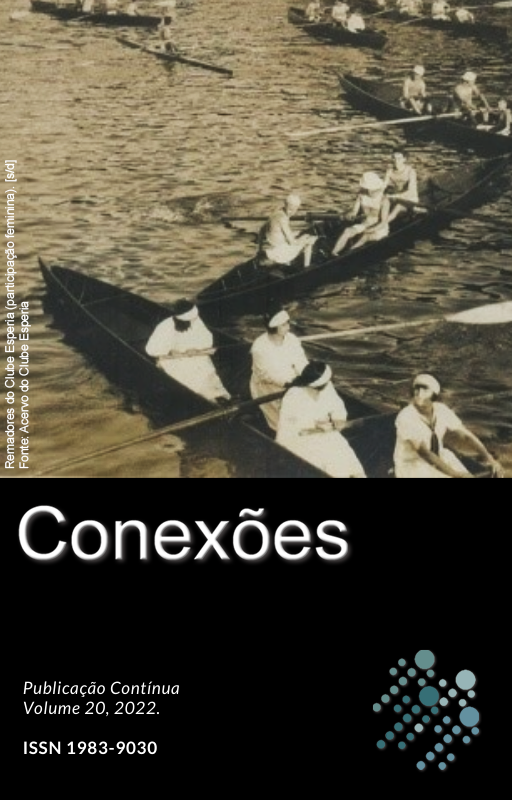Abstract
Introduction: This text in homage to the teacher Simoni Guedes (in memoriam) thematizes the Várzea soccer. In the case, the cultural experience of “Black vs. White”, the soccer game which occurs in the São João Clímaco periphery, São Paulo. Capital, about 50 years ago. The questions that guide this article are: what is the symbolic function of “Black vs. White”? What social bonds are created? What are their ideals, reproducing or reinterpreting, of the dominant order? Objective: The authors aimed to interpret what this soccer game in the São Paulo Várzea represents for the community that promotes it. Method: Therefore, we took as sources 13 interviews of protagonists of the game, the documentary “Black vs. White”, journalistic reports about the event, in addition to the perceptions captured by the participant observation of the phenomenon “from up close and from within”. Results: When approaching and entering the game we discovered that it is a football ritual held annually with the objective of affirming the values that are promoted and preserved by the guardians of that group's memory. This game that celebrates the friendship of black friends and white friends has the symbolic message of showing itself as a collective whose distinctive mark of its identity is the fight against racism. Conclusion: For the community that promotes it, our interpretation is that the “Black vs. White” reveals the relationships about races in Brazilian culture through the cultural experience of a traditional soccer game rooted from São Paulo’s Várzea.
References
ABRAHÃO, Bruno Otávio de Lacerda; SOARES, Antônio Jorge Gonçalves. Futebol e diversidade cultural: Investigando os sentidos da idealização dos jogos “preto x branco” em São João Clímaco/SP. Espaço Plural, v. 14, n. 29, p. 338–360, 2000. Disponível em: https://saber.unioeste.br/index.php/espacoplural/article/view/10437. Acesso em: 20 out. 2021.
ABRAHÃO, Bruno Otávio de Lacerda; SOARES, Antônio Jorge Gonçalves. Futebol e Lazer: Uma Análise sobre o “Racismo à Brasileira” através dos Jogos “Preto x Branco”. LICERE - Revista Do Programa De Pós-graduação Interdisciplinar Em Estudos Do Lazer, v. 15, n. 3, set. 2012. Disponível em: https://doi.org/10.35699/1981-3171.2012.709. Acesso em: 20 out. 2021.
ARCHETTI, Eduardo. Masculinidades: fútbol, tango y polo en la Argentina. Buenos Aires: Antropofagia, 2003.
CHUVA, Marcia. Patrimônio imaterial: práticas culturais na construção de identidades de grupos. In: Contribuições e reflexões para educação patrimonial. Belo Horizonte: SEE/MG, 2002.
DAMATTA, Roberto. Universo do futebol: esporte e sociedade brasileira. Rio de Janeiro: Pinakotheke, 1982.
DAMATTA, Roberto. Carnavais, malandros e heróis: para uma sociologia do dilema brasileiro. 5. ed. Rio de Janeiro: Editora Guanabara, 1990.
DAMO, Arlei Sander. Futebol e identidade social: uma leitura antropológica das rivalidades entre torcedores e clubes. Porto Alegre: Ed. Universidade/UFRGS, 2002.
DAMO, Arlei Sander. Do dom à profissão: a formação de futebolistas no Brasil e na França. São Paulo: Hucitec, 2007.
DAMO, Arlei Sander. Futebol e Antropologia. In: GIGLIO, Sérgio Settani; PRONI, Marcelo Weishaupt (Ed.). O futebol nas ciências humanas no Brasil. Campinas: Editora da Unicamp, 2020.
GEERTZ, Clifford. A interpretação das culturas. Rio de Janeiro: Zahar editores, 1973.
GUEDES, Simone Lahud. Subúrbio: celeiro de craques. In: DAMATTA, Roberto (Org.). Universo do futebol: esporte e sociedade brasileira. Rio de Janeiro: Pinakotheke, 1982.
GUEDES, Simone Lahud. Sentidos, significados e rede de relações em torno do futebol: exemplos analíticos. In: GIGLIO, Sérgio Settani; PRONI, Marcelo Weishaupt (Ed.). O futebol nas ciências humanas no Brasil. Campinas: Editora da Unicamp, 2020.
MAGNANI, José Guilherme Cantor. Quando o campo é a cidade: fazendo antropologia. In: Na metrópole. Magnani, J. C. & Torres, L. de L. (Orgs.). São Paulo: EDUSP, FAPESP, 1996.
MAGNANI, José Guilherme Cantor; SPAGGIATI. Lazer de Dentro e de fora: uma abordagem antropológica (Orgs). São Paulo: Edições Sesc São Paulo, 2018.
MORALES, Wagner. Preto X Branco [filme-documentário]. São Paulo: TV Cultura, 2004.
TELLES, Edward. Racismo à brasileira: uma nova perspectiva sociológica. Rio de Janeiro: Relume Dumará, 2003
WITTER, José Sebastião. A várzea não morreu. In: Meihy, J. C. S. (Org.). Futebol e cultura: coletânea de estudos. São Paulo: Imprensa Oficial do Estado, 1982.

This work is licensed under a Creative Commons Attribution-NonCommercial 4.0 International License.
Copyright (c) 2022 Conexões


